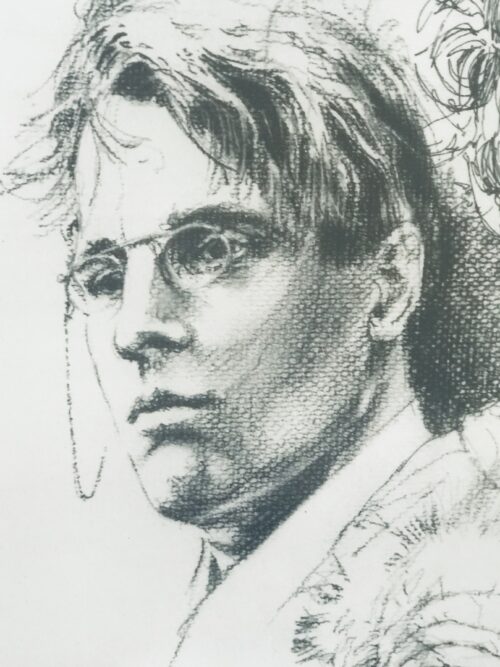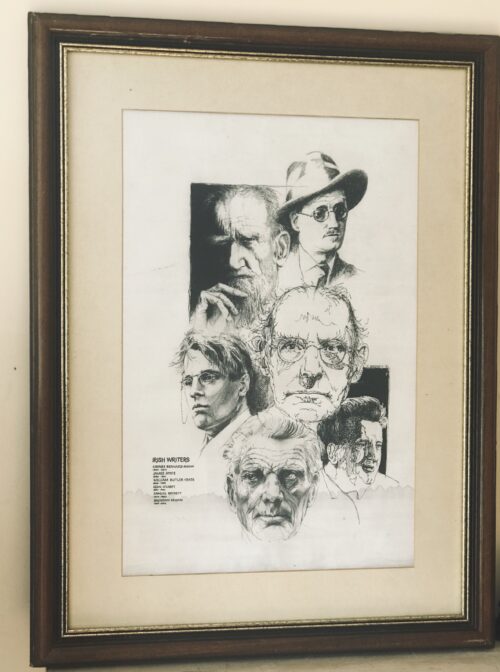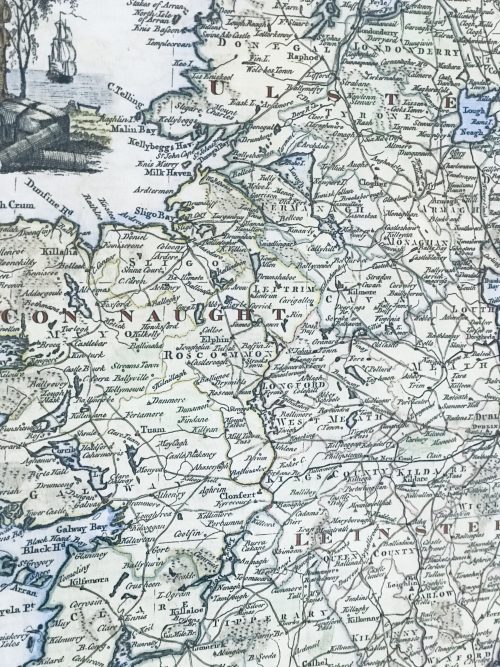|
John B. Keane |
|
|---|---|

Statue of John B. Keane in Listowel, County Kerry. |
|
| Born | John Brendan Keane 21 July 1928 Church Street, Listowel, County Kerry, Ireland |
| Died | 30 May 2002 (aged 73) Listowel, County Kerry, Ireland |
| Nationality | Irish |
| Education | St Michael's College, Listowel |
| Notable works | The Field, Sive |
| Notable awards | Honorary Life Member of the Royal Dublin Society |
| Spouse | Mary O'Connor |
| Children | Billy Keane Conor Keane John Keane Joanna Keane |
-
 Fantastic photo of the late, great John B Keane having an in depth conversation with an old neighbour or friend in north Kerry or West Limerick. Abbeyfeale Co Limerick 24cm x 21cm
Fantastic photo of the late, great John B Keane having an in depth conversation with an old neighbour or friend in north Kerry or West Limerick. Abbeyfeale Co Limerick 24cm x 21cm
John Brendan Keane (21 July 1928 – 30 May 2002) was an Irish playwright, novelist and essayist from Listowel, County Kerry. -

 Striking and large print of a drawing on charcoal depicting five Irish Literary behemoths-James Joyce,W.B Yeats ,Samuel Beckett,Brendan Behan & Sean O'Casey.There is some slight water staining on the bottom of the front as this was stored in the basement of a long closed Dublin pub but now gladly resurrected and reframed. Dublin 90cm x 68cm
Striking and large print of a drawing on charcoal depicting five Irish Literary behemoths-James Joyce,W.B Yeats ,Samuel Beckett,Brendan Behan & Sean O'Casey.There is some slight water staining on the bottom of the front as this was stored in the basement of a long closed Dublin pub but now gladly resurrected and reframed. Dublin 90cm x 68cm -

 Large,colourful,beautifully illustrated and wonderfully eclectic poster depicting some of the best and most iconic Dublin watering holes.This superb poster depicts a variety of the facades,architectural features and idiosyncrasies of many of the best and most celebrated traditional Dublin public houses.Favourite watering holes featured here include; The Stags Head of Dame Court,O'Connells of South Richmond St ,Ryans of Parkgate St, Doheny & Nesbitts of Baggott St ,Ryans of Haddington Road,Slatterys of Rathmines, The Palace Bar of Fleet St,McDaids off Grafton St,Kehoe' s of South Anne St,The International Bar, The Brazen Head,Mulligans of Poolbeg St and Madigans of North Earl St to name but a few. Its fair to say another 50 of these posters could have been commissioned and you still wouldn't run out of timeless classic Dublin watering holes. 57cm x 84 cm
Large,colourful,beautifully illustrated and wonderfully eclectic poster depicting some of the best and most iconic Dublin watering holes.This superb poster depicts a variety of the facades,architectural features and idiosyncrasies of many of the best and most celebrated traditional Dublin public houses.Favourite watering holes featured here include; The Stags Head of Dame Court,O'Connells of South Richmond St ,Ryans of Parkgate St, Doheny & Nesbitts of Baggott St ,Ryans of Haddington Road,Slatterys of Rathmines, The Palace Bar of Fleet St,McDaids off Grafton St,Kehoe' s of South Anne St,The International Bar, The Brazen Head,Mulligans of Poolbeg St and Madigans of North Earl St to name but a few. Its fair to say another 50 of these posters could have been commissioned and you still wouldn't run out of timeless classic Dublin watering holes. 57cm x 84 cm -

 Beautiful depiction of Killarney Co Kerry. These beautiful quaint scenes from six individual towns were originally table and have been superbly mounted and framed to create a memorable souvenir collection.Originally painted by talented local artist Roisin O Shea,the prints depict everyday scenes of streetlife in Killarney,Kilkenny,Blarney,Galway,Kinsale and Youghal. Lahinch Co Clare 33cm x 39cm
Beautiful depiction of Killarney Co Kerry. These beautiful quaint scenes from six individual towns were originally table and have been superbly mounted and framed to create a memorable souvenir collection.Originally painted by talented local artist Roisin O Shea,the prints depict everyday scenes of streetlife in Killarney,Kilkenny,Blarney,Galway,Kinsale and Youghal. Lahinch Co Clare 33cm x 39cm -

 Beautiful depiction of Kinsale Co Cork These beautiful quaint scenes from six individual towns were originally table and have been superbly mounted and framed to create a memorable souvenir collection.Originally painted by talented local artist Roisin O Shea,the prints depict everyday scenes of streetlife in Killarney,Kilkenny,Blarney,Galway,Kinsale and Youghal. Lahinch Co Clare 33cm x 39cm
Beautiful depiction of Kinsale Co Cork These beautiful quaint scenes from six individual towns were originally table and have been superbly mounted and framed to create a memorable souvenir collection.Originally painted by talented local artist Roisin O Shea,the prints depict everyday scenes of streetlife in Killarney,Kilkenny,Blarney,Galway,Kinsale and Youghal. Lahinch Co Clare 33cm x 39cm -

 Beautiful depiction of Galway City. These beautiful quaint scenes from six individual towns were originally table and have been superbly mounted and framed to create a memorable souvenir collection.Originally painted by talented local artist Roisin O Shea,the prints depict everyday scenes of streetlife in Killarney,Kilkenny,Blarney,Galway,Kinsale and Youghal. Lahinch Co Clare 33cm x 39cm
Beautiful depiction of Galway City. These beautiful quaint scenes from six individual towns were originally table and have been superbly mounted and framed to create a memorable souvenir collection.Originally painted by talented local artist Roisin O Shea,the prints depict everyday scenes of streetlife in Killarney,Kilkenny,Blarney,Galway,Kinsale and Youghal. Lahinch Co Clare 33cm x 39cm -

 Beautiful depiction of Kilkenny City. These beautiful quaint scenes from six individual towns were originally table and have been superbly mounted and framed to create a memorable souvenir collection.Originally painted by talented local artist Roisin O Shea,the prints depict everyday scenes of streetlife in Killarney,Kilkenny,Blarney,Galway,Kinsale and Youghal. Lahinch Co Clare 33cm x 39cm
Beautiful depiction of Kilkenny City. These beautiful quaint scenes from six individual towns were originally table and have been superbly mounted and framed to create a memorable souvenir collection.Originally painted by talented local artist Roisin O Shea,the prints depict everyday scenes of streetlife in Killarney,Kilkenny,Blarney,Galway,Kinsale and Youghal. Lahinch Co Clare 33cm x 39cm -

 Beautiful depiction of Youghal Co Cork. These beautiful quaint scenes from six individual towns were originally table and have been superbly mounted and framed to create a memorable souvenir collection.Originally painted by talented local artist Roisin O Shea,the prints depict everyday scenes of streetlife in Killarney,Kilkenny,Blarney,Galway,Kinsale and Youghal. Lahinch Co Clare 33cm x 39cm
Beautiful depiction of Youghal Co Cork. These beautiful quaint scenes from six individual towns were originally table and have been superbly mounted and framed to create a memorable souvenir collection.Originally painted by talented local artist Roisin O Shea,the prints depict everyday scenes of streetlife in Killarney,Kilkenny,Blarney,Galway,Kinsale and Youghal. Lahinch Co Clare 33cm x 39cm -

 Beautiful depiction of Blarney Co Cork. These beautiful quaint scenes from six individual towns were originally table and have been superbly mounted and framed to create a memorable souvenir collection.Originally painted by talented local artist Roisin O Shea,the prints depict everyday scenes of streetlife in Killarney,Kilkenny,Blarney,Galway,Kinsale and Youghal. Lahinch Co Clare 33cm x 39cm
Beautiful depiction of Blarney Co Cork. These beautiful quaint scenes from six individual towns were originally table and have been superbly mounted and framed to create a memorable souvenir collection.Originally painted by talented local artist Roisin O Shea,the prints depict everyday scenes of streetlife in Killarney,Kilkenny,Blarney,Galway,Kinsale and Youghal. Lahinch Co Clare 33cm x 39cm -
Out of stock

 Ferrars History of Limerick was first published in 1787.There are very few copies still in existence and these 5 prints were generously taken from 16 original engravings in the first edition .They depict the Siege of Limerick in 1691,St Marys Cathedral,De Burgos Castle in Castleconnell,The Exchange building and the first page of the book. 35cm x 40cm LimerickThe History of Limerick by James Ferrar published in 1787 is a history of Limerick city from ancient times until the late 18th century. Limerick was an important medieval stronghold, became an important port and trading centre, was subject to a series of sieges in the 17th century and finally experienced a brief golden age of prosperity during the Georgian period of the late 18th century. Limerick or Luimneach was an ancient settlement long before the Vikings captured it and established their own town there in the 9th century. They used it as a base for trade and also to launch raids up the River Shannon against monastic sites like Clonmacnoise and other wealthy Christian centres. However in the 11th century the last Viking king of Limerick was defeated by King Brian Boru. In 1174, the Norman conquerors who had already seized Dublin , Leinster and Munster captured the city of Limerick . It was given its city charter by King Richard I in 1197 and a castle fortress was built by King John about 1200. The medieval city featured a walled town known as Englishtown on the north side of the River Shannon. Irishtown was inhabited by the Irish and Vikings was on the south side of the river. Both were eventually walled and linked by bridges over the Shannon . Limerick would retain formidable defenses until the 17th century when it experienced four separate sieges during the period of the English Civil War and the Williamite Wars. Catholic rebels forced the English garrison to surrender in 1642 and a Parliamentarian Army in turn forced a Catholic and Royalist garrison to surrender in 1651. It was twice besieged in 1690 and 1691 by the forces of William III of Orange who forced Jacobins fighting on the sides of the Catholic James II to surrender and go into exile. From the late 17th to the 19th centuries an Anglo-Irish Protestant elite controlled Ireland . In Limerick in the late 1700s Limerick merchants prospered and Edmund Pery, 1st Viscount Pery had much of the south side of the city redesigned with a grid of Georgian brick terraces and neo-classical stone buildings. The Georgian area still survives in the 21st century and Prey Square is named in Edmund Prey's honour. Unfortunately the Irish economy declined in the early 19th century as the Irish Parliament was switched from College Green, Dublin to the House of Commons in London and Ireland remained a near feudal agricultural society as Britain rapidly industrialised. Like Dublin , Limerick 's best days were behind it as slums flourished and in the 1840s the city population swelled as the poor fled from the land after the failure of the potato crop.
Ferrars History of Limerick was first published in 1787.There are very few copies still in existence and these 5 prints were generously taken from 16 original engravings in the first edition .They depict the Siege of Limerick in 1691,St Marys Cathedral,De Burgos Castle in Castleconnell,The Exchange building and the first page of the book. 35cm x 40cm LimerickThe History of Limerick by James Ferrar published in 1787 is a history of Limerick city from ancient times until the late 18th century. Limerick was an important medieval stronghold, became an important port and trading centre, was subject to a series of sieges in the 17th century and finally experienced a brief golden age of prosperity during the Georgian period of the late 18th century. Limerick or Luimneach was an ancient settlement long before the Vikings captured it and established their own town there in the 9th century. They used it as a base for trade and also to launch raids up the River Shannon against monastic sites like Clonmacnoise and other wealthy Christian centres. However in the 11th century the last Viking king of Limerick was defeated by King Brian Boru. In 1174, the Norman conquerors who had already seized Dublin , Leinster and Munster captured the city of Limerick . It was given its city charter by King Richard I in 1197 and a castle fortress was built by King John about 1200. The medieval city featured a walled town known as Englishtown on the north side of the River Shannon. Irishtown was inhabited by the Irish and Vikings was on the south side of the river. Both were eventually walled and linked by bridges over the Shannon . Limerick would retain formidable defenses until the 17th century when it experienced four separate sieges during the period of the English Civil War and the Williamite Wars. Catholic rebels forced the English garrison to surrender in 1642 and a Parliamentarian Army in turn forced a Catholic and Royalist garrison to surrender in 1651. It was twice besieged in 1690 and 1691 by the forces of William III of Orange who forced Jacobins fighting on the sides of the Catholic James II to surrender and go into exile. From the late 17th to the 19th centuries an Anglo-Irish Protestant elite controlled Ireland . In Limerick in the late 1700s Limerick merchants prospered and Edmund Pery, 1st Viscount Pery had much of the south side of the city redesigned with a grid of Georgian brick terraces and neo-classical stone buildings. The Georgian area still survives in the 21st century and Prey Square is named in Edmund Prey's honour. Unfortunately the Irish economy declined in the early 19th century as the Irish Parliament was switched from College Green, Dublin to the House of Commons in London and Ireland remained a near feudal agricultural society as Britain rapidly industrialised. Like Dublin , Limerick 's best days were behind it as slums flourished and in the 1840s the city population swelled as the poor fled from the land after the failure of the potato crop.










